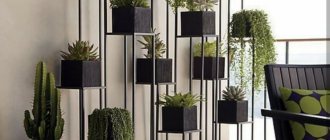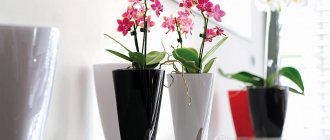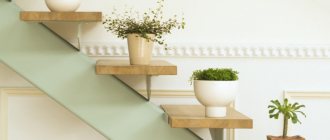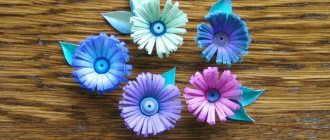/Accessories and decor/Decoration/
Indoor plants and flowers in the kitchen interior are always beautiful and useful - they refresh the air and add coziness, color, and make it feel lived-in. But the kitchen is not the best place to start a home garden due to sudden temperature changes, an abundance of greasy fumes and high humidity. Therefore, when choosing indoor plants and flowers for the kitchen, you should not focus only on their beautiful appearance. After all, the flowering specimen you liked in the store may turn out to be completely unsuitable for life in the conditions of this room.
But still, there are several plants and indoor flowers that can and should be grown in the kitchen. Let's figure out what kind of plants and indoor flowers these are, how to care for them and where it is best to place them.
How and where to properly keep flowers in the kitchen
When determining which plants are best suited for your kitchen, you need to consider the lighting in the room. For the north side, shade-tolerant specimens are selected - the same sansevierias, zamioculcas, ficuses with dense green leaves. And for a well-lit kitchen, you can choose a palm tree, hibiscus, croton or even an orchid.
The most important rule is to find out what plant care requirements are before purchasing. This way you will avoid unnecessary expenses and disappointments.
Even the most unpretentious flowers in the kitchen will not last long if they are placed incorrectly. Here are the following recommendations:
- Plants should not be placed near the sink - none of them will withstand constant splashes of grease and soapy water.
- Flowers in the kitchen should correspond to the dimensions of the room - the more spacious the room, the larger the specimens will be appropriate in it.
- Do not forget that decorative deciduous ones are often more unpretentious than flowering ones. And the latter are very sensitive to lack of light.
- Flowers should not be placed near the stove, above the burners, or near a window open for ventilation (in winter).
- The air at the top is the driest, so the plants located here will have to be watered and sprayed more often.
- Strong-smelling flowers are not the best choice for this room, but fragrant spices will be just right.
- You can also decorate the dining table with potted plants - but it’s better to choose a miniature and completely healthy specimen.
See also the material: DIY paper flowers - 4 master classes for beginners.
For a sunny kitchen
Now let’s talk about what flowers you can keep in your kitchen if there is an excess of sunlight in it. A good solution for such premises are those plants that are not new to such conditions. That is, if their natural habitat is in the desert or steppe regions of the planet.
Flowers in a sunny kitchen always look fresh and bright
Succulents
These plants have completely different origins, but they are all equally resistant to drought. They will tell you about overwatering - their fleshy leaves will begin to thin or wrinkle.
Soil: for succulents and cacti. Watering: in summer, succulents are watered no more than once every 1-2 weeks (or even less often), and in winter - even less often. Temperature: 7-35 degrees.
They are not afraid of drafts, they are hypoallergenic, mostly non-toxic and are unlikely to be of interest to pets - although anything can happen. There is no need to spray succulents, but you can periodically wash them from the shower with non-hot water, while avoiding waterlogging of the soil.
We will give just a couple of examples, but these characteristics apply to other succulents as well. And, believe me, there are a lot of them.
Geranium
The beloved Geranium (Geranium), or cranebird, is a member of the Geranium family, but the plant that we used to call geranium actually belongs to another genus of the same family - Pelargonium.
Pelargonium is useful because its leaves contain a large amount of essential oils, which kill pathogens and have a beneficial effect on human health, having a calming effect. Geranium essential oil is widely used in perfumery and aromatherapy.
Crassula
Most often, Crassula ovata (Crassula ovata) is grown as a houseplant. This flower is known to many by other names: money tree, tree of luck, jade (jadeite) plant. Crassula received these names because of the external resemblance of the leaves to jade and jadeite - stones that have been considered since ancient times as talismans bringing success, happiness, family well-being and longevity.
Crassula feels good on western and south-eastern windows. It filters and humidifies the air, which is why it is often kept in the kitchen.
Epipremnum
Epipremnum was formerly known as scindaptus. Like chlorophytum, it perfectly filters the air from excess carbon dioxide, which is a by-product of the use of gas burners. Epipremnum is easily identified by the presence of fleshy leaves of rich green color located at the ends of long vines. This culture is evergreen and heat-loving. The plant is not able to develop if there is a lack of sunlight or in cold and dry conditions, so the kitchen becomes the optimal place of residence for it. It is important to mention that it will not be able to grow in gloomy northern rooms.
Since vines are actively formed during the development of the epipremnum, it is necessary to select a place for it taking into account this feature. Ideally, long shoots are located along the wall or along the upper shelves. In addition to standard care, the plant requires periodic wiping of dust from the leaves and spraying them.
Phalaenopsis orchid
An epiphytic plant, considered the most unpretentious of all those cultivated indoors. Consists of 4-6 wide, thickened and shiny, leathery leaves ranging from 5-30 cm in length. Grayish-greenish thick (up to 8 mm) aerial roots and branching flower shoots emerge from the axils, reaching up to 60-70 cm in height. Large , spectacularly and variedly colored flowers are extremely reminiscent of an outlandish tropical butterfly with open wings.
A tropical culture that loves warmth feels good at stable temperatures in the kitchen around +22...+25 °C (with a difference between day and night of about 5 °C). Water the indoor flower moderately using the immersion method. Spray regularly (water should not get into the sinuses), maintaining humidity. The length of daylight hours is recommended to be at least 14-15 hours.
Ivy
An evergreen, climbing or creeping, liana-like, shrubby plant, scientifically called hedera. Long petioled leaves, usually having 3 or 5 wide lobes, sit alternately (in a checkerboard pattern) and tightly on the long lashes. The leaf blades are dense, leathery, plain or variegated (striped, spotted, etc.) with pronounced veins. Small greenish-yellowish flowers are not particularly beautiful.
Indoor ivy most prefers moderate and slightly diffused natural light in the kitchen, but can grow well under artificial lighting. The flower tolerates short-term cold snaps down to +5 °C; in winter it likes cool weather (+10…+15 °C). Watering is regular and plentiful; the earth clod should not be allowed to dry out. All parts of the plant, especially the fruits, are considered poisonous.
cacti
Plants with thickened stems of various shapes and sizes (ribbed, papillary, flat, etc.), covered with needles, hairs or bristles - modified leaves of various colors and lengths. The flowers are tubular, funnel-shaped, sometimes very fragrant.
Succulents that do not need frequent watering, but require maximum brightness in the kitchen. In winter, indoor cacti must be kept cool, otherwise flower buds will not form at all.
Begonia
When choosing begonia to decorate your kitchen, you should give preference to special indoor varieties that bloom both in summer and winter. The plant does not like shade, so it should only be planted in kitchens facing west, south or east. The optimal light for begonia is bright and diffused. Despite the fact that the plant feels good in high humidity, it is not worth spraying it additionally, as this threatens the appearance of dark, unsightly spots.
Begonia, like the other plants mentioned above, participates in air filtration due to the release of phytoncides.
Pilea Cadieux
A member of the nettle family (Urticaceae), Pilea (Pilea) is quite popular in indoor floriculture. Plants of this genus amaze with their variety of shapes and colors. One of the most interesting species is Pilea cadierei.
Thanks to its exquisite shape, the Pilea will perfectly decorate any interior. Its beneficial effect on the composition of the air in the house is also known. To prevent the silver pattern on the leaves of this plant from fading, place the pot on a north or east window: this way the pilea will avoid being burned by direct sunlight, while still receiving enough light.
Aloe
There are more than 30 types of agave, differing in shape and color - for example, as in the photo. The older the aloe, the less often it needs to be watered.
It is very easy to care for: plant it in special soil for succulents and cacti, but it will just as well grow in soil dug up in the yard or park.
Aloe rarely blooms. Therefore, you can choose something different for the kitchen.
Kolanchoe
Flowering species - Kolanchoe Blossfeld, Mangus and Kalandiva need to be removed or covered from the sun after 3 o'clock in the afternoon. Less demanding in this case are the viviparous Kolanchoe - tubular-flowered, pinnate or Degremona.
The dissected-leaved kolanchoe or “deer antlers” also has an unusual appearance. Even on dimly lit windows it will delight you with bright yellow flowers.
Aspidistra
Add an unusual aspidistra bush to your kitchen - it requires no effort at all. A bright green plant with large leaves will bear much more than many others. It can cope with lack of light, intense heat, and infrequent watering. No matter how little gardening skill you have, you are unlikely to kill this plant. Why is it useful in the kitchen? The thing is that you probably want to decorate the room, but it is difficult to be responsible for the conditions in it: sometimes it is damp and cool, sometimes hot and dry. Aspidistras will be able to put up with such conditions without any problems. Even if you plan to leave for a long time, you don’t have to worry about these plants - they are guaranteed to survive your absence and will continue to delight you with their fresh green appearance.
When toothpaste is harmful to children: permissible age doses
The newlyweds traveled all over the world and took wedding photos in every country
Seven daily habits of happy people
Pilea
If everything in your kitchen is decorated with stainless steel, the green-silver leaves of this plant will fit perfectly into the interior. Plant your pilea in a hanging pot, away from strong air currents such as a heater or air conditioner. This plant is perfect for the kitchen because it is easy to care for, and its silvery leaves are very unusual and decorate any interior well. Plus, it's a hanging plant, which means you'll save shelf space if that's an issue. The interesting and unusual appearance of Pilea leaves is guaranteed to attract attention, and you will not need to spend a lot of time caring for or worrying about this plant.
Only on a soft spot: Russian Domostroy forbade punishing children in any other way
The star of the series “Sultan of My Heart” spoke about the choice of his future wife
25 children of a childless man: an extraordinary reunion
A few more ways to garden your kitchen
The most luxurious flowers in the kitchen interior are the beautifully blooming specimens that decorate the windowsill: begonia and saintpaulia, kalachik (geranium), primrose, azalea. Schefflera and dracaena are suitable for placement in the center of the dining group.
Coffee trees, decorative peppers, miniature pomegranates or an impressively sized lemon tree will harmoniously complement the kitchen style. Calathea, balsam or arrowroot can be placed a short distance from the sink (so that splashes of detergent do not fall on the plants).
Enough light, but don't want to water your plants often? It is worth paying attention to succulents - cacti, agaves, aloe, crassula or spathiphyllum.
If there is no hood in the room, and the problem is solved by frequent ventilation, then suitable flowers are zebrina, tradescantia, chlorophytum, scindapsus, hypoestes, and begonia. All these plants are immune to drafts.
Flowers in the kitchen interior can also be placed in the form of an impressive green oasis. If the room is spacious, then the basis of such a composition will be large plants in tubs - hibiscus, monstera, ficus, yucca, dracaena.
If the kitchen is decorated with racks and shelves, then the green decor will be ampelous plants - such as ivy, passionflower, tradescantia, scindapsus or chlorophytum. For plants in this group, you can also make special decorative stands or pendants. And don't forget that the kitchen is the place where you can grow herbs - mint and watercress, dill and parsley, thyme and basil.
English ivy
Your kitchen will become more beautiful if you hang this plant over the sink or near the window. English ivy is easy to grow indoors as long as it receives direct sunlight. In addition, the plant will be an excellent color accent. Its sharp leaves come in different shades of green with yellow, white or black spots, so you're sure to find a color that suits you. Why is ivy needed in the kitchen? It helps purify the air by removing pollutants such as formaldehyde, benzene, mold and bacteria, thereby protecting your health. Just keep the pot away from pets, as ivy leaves are poisonous to dogs, cats and other animals.











